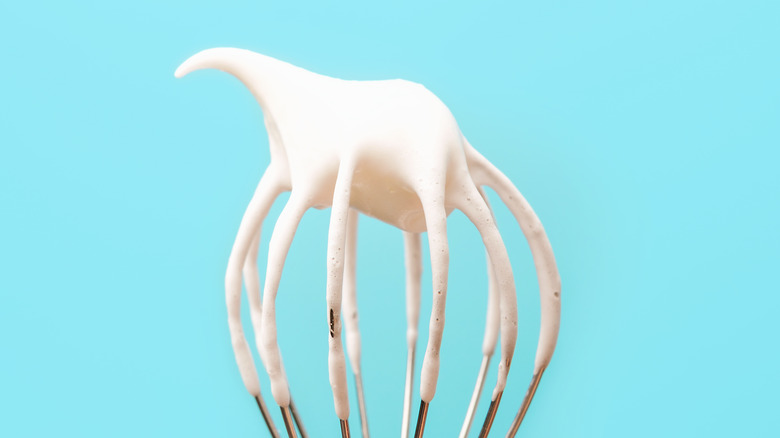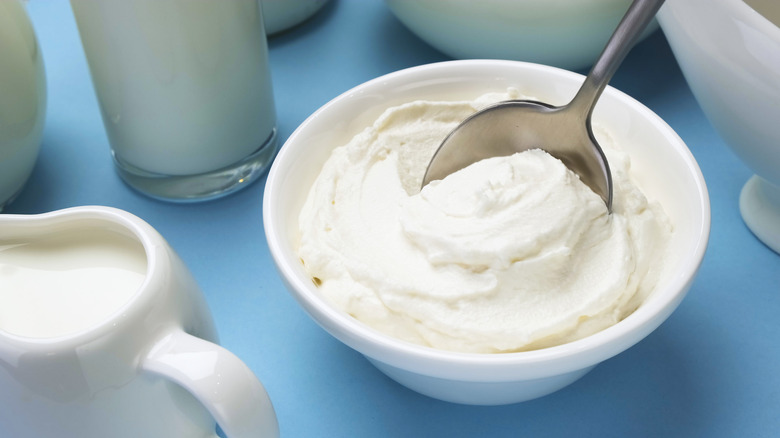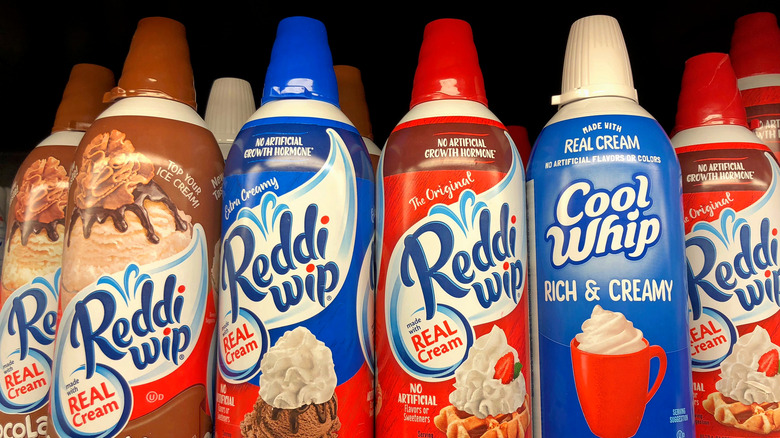Whipped Cream Has Been Around For A Long, Long Time
If there is any dessert that isn't instantly improved by the addition of whipped cream, we have yet to meet it. Doesn't every ice cream sundae deserve a cherry-bejeweled cream crown? Shouldn't every cup of cocoa leave you with a fluffy white mustache? Whipped cream is more than a food; it's a feeling that simultaneously evokes comfort and opulence in a way nothing else does. It feels fit for a king when delivered as a dainty quenelle at a fine dining restaurant, but squirt a can of it straight into your mouth, and you'll instantly feel like a child again. Whether you make your own whipped cream from scratch or buy it in a can, it's perfect for elevating a dish from good to great. Now, it shouldn't surprise you to learn that spray cans are a relatively recent invention, but as for whipped cream itself, the story starts much earlier.
Whipped cream recipes date back to the Renaissance
The earliest written recipe for whipped cream appears to have come from Renaissance Italy, courtesy of Cristoforo di Messisbugo, a chef in the court of Alfonso I d'Este, the Duke of Ferrara. Messisbugo's 1549 cookbook Banchetti composizioni di vivande e apparecchio generale (roughly translated to "Banquets, Recipes and General Utensils for the Kitchen and the Table") includes an entry for whipped cream under the name Lattemelle.
Whipped cream was further popularized by Bartolomeo Scappi, the most famous chef of the Renaissance era and one of the most influential chefs of all time. Scappi served as the personal cook to six different popes, leading the Vatican kitchen at the same time that Michelangelo was painting the Sistine Chapel next door. He bestowed a new name upon whipped cream that encapsulates the sense of wonderment it evoked among the era's populace: neve di latte, or milk snow.
Recipes for whipped cream spread throughout Europe in the 17th century. 1604's Ouverture de Cuisine, by French chef Lancelot de Casteau, includes an entry titled Pour faire neige (to make snow). It describes the process of making whipped cream, but with the unique addition of rosewater for flavor. Rosewater also appears in 1575's A Proper Newe Booke of Cookery, which features a recipe for a dyschefull of snowe. This might be the first whipped cream recipe written in English, and it is notable for the inclusion of beaten egg whites to reinforce the structure.
The whipped cream world changed dramatically in the 20th century
Initially, whipped cream was quite challenging to make. The only whipping tools available in those days were tree branches and rushes, which were far from efficient. Lancelot de Casteau's recipe requires beating the cream for half an hour. Fortunately, the whisk was invented around 1850, and hand-cranked egg beaters debuted in 1856. This dramatically sped up the work, yet people still wanted a shortcut. This was apparent in 1948 when a St. Louis dairy salesman named Aaron Lapin released the first sprayable whipped cream. He gave it a name you probably recognize: Reddi-Whip.
The 20th century also brought dairy-free alternatives to whipped cream. The first of these came in 1904, invented by Ella Eaton Kellogg, the wife of John Harvey Kellogg, one of the brothers behind Kellogg's cereal. The Kellogg's were early advocates of veganism, and Ella's plant-based alternative relied on almond butter. A few decades later, dairy rationing during World War II paved the way for more alternatives, most notably Cool Whip, which was initially dairy-free, but now includes milk. These whipped toppings, as they are known, were so popular that between 1962 and 1972, sales of real whipped cream dropped 30%. The landscape changed in the 1970s when ultra-pasteurized cream became the norm for grocery stores. Its lower fat content makes it harder to whip and less rich. Though undoubtedly delicious, the whipped cream we enjoy today is a far cry from its Renaissance glory. As with most food and beverage, it has evolved with new inventions, new recipes, and new healthy habits.


